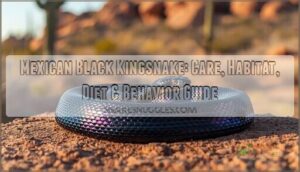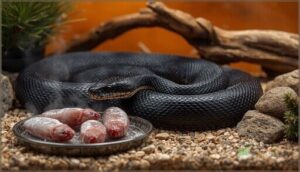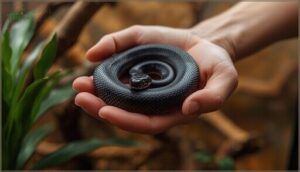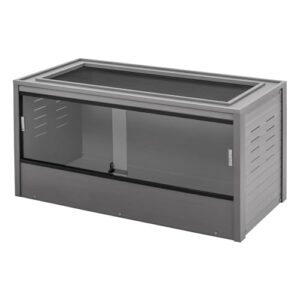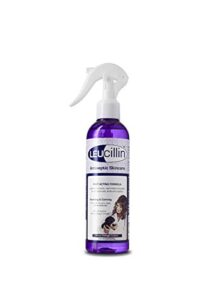This site is supported by our readers. We may earn a commission, at no cost to you, if you purchase through links.
Most snake keepers stumble into kingsnake ownership by accident—they see that glossy midnight scales catching light like an oil slick, and logic goes out the window. The Mexican black kingsnake earns its reputation as one of the most visually stunning colubrids in the hobby, with iridescent blues and purples rippling across jet-black scales that look almost liquid in motion.
But here’s what separates this species from other eye-candy reptiles: it backs up those looks with genuine hardiness and a temperament that won’t punish beginners for minor mistakes. Native to the sun-scorched deserts of southern Arizona and northwestern Mexico, these adaptable constrictors have evolved to thrive in conditions that would stress out more delicate species.
You’ll find everything from proper thermal gradients to feeding schedules matters less if you nail the fundamentals first.
Table Of Contents
- Key Takeaways
- Mexican Black Kingsnake Species Overview
- Ideal Habitat and Enclosure Setup
- Diet and Feeding Guidelines
- Behavior, Temperament, and Handling
- Top 3 Products for Mexican Black Kingsnake Care
- Frequently Asked Questions (FAQs)
- Is the Mexican black kingsnake venomous?
- Are Mexican Black Kingsnakes bitey?
- What is the personality of a Mexican black kingsnake?
- Do Mexican Black Kingsnakes lay eggs?
- Is a Mexican black kingsnake a good pet?
- Are black kingsnakes aggressive?
- How often do Mexican black kingsnakes shed their skin?
- Can Mexican black kingsnakes recognize their owners?
- Are Mexican black kingsnakes good for beginners?
- Do Mexican black kingsnakes hibernate in captivity?
- Conclusion
Key Takeaways
- Mexican black kingsnakes combine stunning iridescent black coloration with genuine hardiness, thriving in 90-120°F thermal gradients that mirror their native Sonoran Desert habitat while tolerating beginner mistakes better than most species.
- These nonvenomous constrictors require a 48×24×24-inch enclosure with proper substrate depth for burrowing, two hides on opposite thermal zones, and 40-60% humidity maintained through adequate ventilation to support their 20-30 year lifespan.
- Feeding schedules differ dramatically by age—juveniles need appropriately-sized frozen-thawed prey every 5-7 days to fuel rapid growth, while adults settle into a 10-14 day rhythm once they reach their full 90-120 cm length.
- While naturally docile once acclimated, these snakes show strong feeding responses that demand respect, and consistent weekly handling starting with brief 5-minute sessions builds trust while avoiding the 24-48 hour post-feeding window prevents stress-induced regurgitation.
Mexican Black Kingsnake Species Overview
The Mexican black kingsnake stands out as one of the most striking reptiles you can keep in captivity, with jet-black scales that shimmer with iridescent blues and purples.
Native to the arid landscapes of southern Arizona and northwestern Mexico, this non-venomous colubrid has earned a reputation as a hardy, adaptable species that thrives under proper care.
Before you bring one home, you’ll want to understand the basics of what makes this snake unique—from its taxonomy and natural range to its physical traits and long-term growth.
Scientific Classification and Range
The Mexican black kingsnake, scientifically known as Lampropeltis getula nigrita, calls the Sonoran desert home—spanning northwestern Sinaloa through southern Arizona. Taxonomic history shows ongoing phylogenetic analysis, with some authorities elevating it to full species status as Lampropeltis nigrita after 2017.
Geographic range remains relatively localized compared to other kingsnakes, though conservation status sits at “Least Concern” thanks to stable populations. Species distribution includes rocky desert habitats where these glossy serpents thrive. The Mexican black kingsnake’s ability to adapt to different environments is due to its semi desert habitats.
Physical Characteristics and Coloration
This species’ most striking feature is its glossy black coloration with an iridescent sheen, resembling polished obsidian. The smooth scale texture enhances its reflective quality, while melanistic traits dominate—though some juveniles show faint yellow spotting that fades over time.
Adult Lampropeltis getula nigrita generally stretch 90–120 cm, occasionally reaching 150 cm in captivity. Color morphs exist through selective breeding, including albino variants, but wild specimens remain uniformly dark. It’s a nonvenomous snake built for stealth and adaptability.
The common kingsnake’s geographic range and behavior can be understood through studying kingsnake habitats.
Lifespan and Growth Expectations
Beyond that glossy exterior lies a long-term commitment. With proper Mexican Black Kingsnake care, you’re looking at 20–30 years together—a lifespan that demands respect. Growth patterns slow after the first few years, but longevity tips like stable temps and consistent feeding make all the difference in reptile husbandry.
Mexican black kingsnakes demand a 20–30 year commitment, thriving on stable temperatures and consistent feeding throughout their long lives
- Hatchlings start at 9–13 inches, reaching adult size within 2–3 years
- Growth rate drops sharply once they pass the 60 cm mark
- Captive specimens often outlive wild counterparts due to reduced parasites and steady nutrition
Ideal Habitat and Enclosure Setup
Creating the right home for your Mexican black kingsnake isn’t complicated, but it does require attention to a few key details.
Getting the enclosure size, substrate, temperature, and enrichment right will set your snake up for a long, healthy life.
Here’s what you need to know to build a habitat that meets their natural needs.
Enclosure Size Recommendations
Your snake’s enclosure size directly determines its quality of life. For adult Mexican black kingsnake care and maintenance, you’ll need a minimum 48×24×24-inch tank—that’s 4×2×2 feet of floor space. Hatchlings thrive in 36×18×18-inch setups, but plan to upgrade once your snake reaches 36 inches.
Proper enclosure dimensions and ventilation systems prevent stress, support natural behaviors, and align with serious kingsnake care standards.
Substrate and Decor Options
Your substrate types and decorations form the foundation of a proper enclosure setup—they’re not just aesthetic choices. For burrowing options and humidity control, choose from these proven decor materials:
- Aspen shavings for dry, dig-friendly bedding
- 60% topsoil/40% sand mix for bioactive substrate
- Cork bark caves for secure hiding spots
- Sturdy branches for environmental enrichment
- Moist moss boxes for localized humidity zones
Paper towels work for quarantine, but loose substrates support natural snake habitat behaviors.
Temperature, Lighting, and Humidity Needs
To nail your thermal gradients, set a basking zone at 85–90°F and a cool side around 75–80°F using an overhead heat lamp paired with a reliable thermostat. A digital thermometer on each end ensures your temperature gradient stays dialed in.
Maintain humidity levels between 40–60% with proper ventilation systems to prevent respiratory issues.
Install UVB lighting on a 10–12 hour cycle—you’ll notice improved activity and appetite.
Enrichment and Hiding Spaces
Your kingsnake’s mental health depends on smart hide placement. Position at least two opaque shelters on opposite thermal zones so it can thermoregulate without exposure.
Add cork bark tunnels and hollow logs for environmental enrichment, then layer substrate depth of 4–6 inches to encourage natural burrowing behavior.
Include one humid hide with damp sphagnum moss on the cooler side to support clean sheds in your bioactive enclosure.
Diet and Feeding Guidelines
Feeding your Mexican black kingsnake properly is essential for its health and longevity, and understanding what these obligate carnivores need will help you create a sustainable feeding routine.
In the wild, they’re opportunistic predators with a diverse palate, but captivity requires a more controlled approach to nutrition.
Here’s what you need to know about their dietary needs, from selecting the right prey to establishing feeding schedules that match their age and metabolism.
Natural Diet in The Wild
In their native Sonoran Desert, Mexican black kingsnakes (Lampropeltis getula nigrita) roam as opportunistic predators, exploiting the desert ecology’s rich buffet. Their wild ancestors displayed impressive venom resistance, tackling rattlesnakes alongside gentler fare. Understanding this wildlife and ecology helps you appreciate their carnivorous nature:
- Snake prey (including venomous species)
- Rodents and small mammals
- Lizards and other reptiles
- Reptile eggs and bird eggs
- Ground-nesting birds
Wild foraging shapes their captive needs entirely.
Feeding Schedule for Juveniles and Adults
Your Mexican black kingsnake’s feeding frequency hinges on age and growth rates. Juveniles thrive on 5–7 day intervals, fueling rapid development and meeting elevated nutrient needs. Adults settle into a comfortable 10–14 day rhythm once growth plateaus.
This staggered feeding schedule respects their digestion cycle—usually 48 hours from meal to defecation—and prevents the pitfalls of overfeeding in snake care and maintenance.
Choosing Safe and Appropriate Prey
Prey selection isn’t just about size—it’s about safety, nutrition, and your snake’s long-term health. Whole prey items deliver complete nutrient balance without supplements, while frozen-thawed prey eliminates bite wounds that live rodents can inflict within minutes.
Essential kingsnake care feeding safety guidelines:
- Match prey width to your snake’s widest body circumference—never exceed it to prevent regurgitation
- Choose frozen-thawed prey over live to avoid defensive rodent injuries
- Select whole prey (mice, rats) for complete calcium and organ nutrition
- Source commercially bred rodents from regulated facilities for consistent quality
- Wash hands 20+ seconds after handling any feeder rodents or reptile care items
Feeding Techniques and Safety Tips
Once you’ve chosen safe prey, how you present it matters just as much. Thaw frozen rodents in the refrigerator for 12–24 hours, then warm them in sealed bags submerged in warm water—never refreeze leftovers.
Use feeding tongs to wiggle prey from the side, keeping your hands 20–30 cm back to prevent accidental bites.
Wait 24–48 hours post-feeding before handling to avoid stress-induced regurgitation.
Behavior, Temperament, and Handling
Mexican black kingsnakes are generally docile and adapt well to handling, but their temperament depends heavily on how you interact with them from day one. With consistent, gentle handling, these snakes become calm and tolerant, though occasional defensive behavior is normal—especially in younger individuals.
Understanding their natural behaviors and learning to read their body language will help you build trust and avoid unnecessary stress for both of you.
Typical Temperament and Behavior Traits
Generally, Mexican black kingsnakes are docile and tractable in captivity, making them popular among intermediate keepers seeking rebellious confidence in snake handling. Juveniles often display feistier defensive behavior—striking and musking—while adults shift to calm, exploratory temperament traits within 1–2 years.
Their strong feeding response demands respect; they’ll occasionally mistake your hand for prey, especially around mealtimes when their food-driven instincts peak.
Handling Best Practices
When you’re ready to handle your kingsnake, approach from below and let the snake crawl onto your hands rather than grabbing from above—this gentle touch prevents defensive strikes. Support the full body length during handling and interaction to avoid stress. Wash your hands thoroughly before and after every session to prevent Salmonella transmission and reduce bite prevention concerns tied to food scent.
Key handling techniques for confident snake care:
- Wait 24–48 hours after feeding to protect digestion and prevent regurgitation—kingsnake care demands this patience
- Limit early sessions to 5 minutes, gradually extending time as your snake relaxes into your routine
- Handle at least weekly to maintain trust, but never more than once daily for best stress reduction
Reducing Stress and Defensive Responses
Beyond gentle handling techniques, you’ll master stress reduction by creating an environment that honors your Mexican black kingsnake’s natural instincts. Environmental enrichment—multiple hides, burrowing substrate, and structural complexity—cuts defensive behavior dramatically by letting your snake retreat when needed.
Studies show enriched enclosures lower stress hormones and eliminate escape-seeking behaviors. Skip handling during pre-shed periods when cloudy eyes trigger heightened fear responses, and you’ll watch defensive strikes vanish.
Signs of Aggression or Discomfort
Vigilance separates confident keepers from those fumbling through fear-driven encounters. Your Mexican black kingsnake telegraphs discomfort through clear behavioral cues—watch for these aggression signs and stress factors before handling backfires:
- S-shaped coiling with raised head: Classic defensive posture signaling imminent strike readiness
- Rapid tongue flicking with hissing: Heightened arousal indicating your approach crossed comfort boundaries
- Musking combined with thrashing: Chemical warfare—acute distress demanding immediate space
Juveniles bite more frequently until habituated, so decode these discomfort indicators early.
Top 3 Products for Mexican Black Kingsnake Care
Getting your Mexican black kingsnake set up right comes down to choosing the right gear from the start. You don’t need a garage full of equipment, but a few quality essentials will make all the difference in keeping your snake healthy and your maintenance routine straightforward.
Here are three standout products that cover the core needs for housing, health, and long-term care.
1. Eco Friendly Reptile Habitat Enclosure
Your Mexican black kingsnake deserves more than a cage—it deserves a sustainable home that respects both your pet and the planet.
The ECOFLEX 95-gallon terrarium offers 48″ of horizontal space, meeting the 4×2-foot footprint ideal for adult colubrids. It uses moisture-resistant wood-plastic composite, which has a lower environmental impact than virgin PVC.
Its bioactive enclosure compatibility accommodates natural substrates like coco coir, and the vented design allows precise temperature gradients. This green habitat proves eco-friendly designs don’t compromise on snake habitat quality or reptile enclosure setup functionality.
Best For: Snake owners who want a spacious, low-impact enclosure that supports bioactive setups and reduces long-term material waste.
- 48″L x 24″W footprint hits the sweet spot for adult colubrids without needing upgrades later, cutting down on replacement waste over your snake’s lifespan.
- Moisture-resistant ECOFLEX composite uses less energy to produce than virgin PVC, and it holds up well in humid bioactive environments with natural substrates like coco coir.
- Vented panels and mesh top let you dial in temperature gradients with low-heat LEDs and independent heating, keeping energy use down while your snake stays comfortable.
- No built-in cord ports means you’ll need to drill your own holes, which could compromise the moisture seal if you’re not careful.
- The large mesh top makes it tough to hold humidity for species that need it, and you may have to add coverings or sealant—extra materials that offset some eco benefits.
- Mesh lid won’t support heavy objects, so if you’re stacking gear or decorations on top, you’ll need a separate solution.
2. Bearded Dragon Reptile Tank Enclosure
You’ll find the Phailozoo 120-gallon terrarium transforms your kingsnake care routine with serious upgrades. This 48″×24″×24″ snake enclosure delivers generous floor space—your adult kingsnake won’t feel cramped as it explores.
Tempered glass doors open wide for easy feeding, while top screen ventilation systems maintain airflow without sacrificing heat retention. The rigid enclosure materials support heating elements and lighting designs you’ll mount overhead.
Tank size options matter, and this reptile enclosure setup hits the sweet spot between spacious and manageable for experienced keepers ready to level up.
Best For: Keepers upgrading from smaller enclosures who want a spacious, front-opening terrarium with solid ventilation and enough room for adult bearded dragons to thermoregulate properly across a full temperature gradient.
- The 48″×24″×24″ footprint meets the minimum 4×2×2 standard for adult bearded dragons, giving them actual space to move between basking and cool zones instead of feeling trapped.
- Front-opening tempered glass doors make feeding and cleaning way easier than top-entry tanks, and the rigid construction supports overhead heat lamps and UVB fixtures without sagging.
- Top screen ventilation keeps air moving without turning the enclosure into a draft tunnel, which helps you dial in that 30-40% humidity sweet spot bearded dragons need.
- It’s not leakproof out of the box, so if you’re planning a bioactive setup with drainage layers you’ll need to add sealant yourself before things get messy.
- No door lock means curious kids or dogs might pop it open, and some customers have reported the tempered glass shattering during shipping or installation.
- At this price point it’s definitely an investment compared to budget terrariums, and parts like the vents can be fragile if you’re not careful during assembly.
3. Natural Pet Antiseptic Skin Spray
When mouth rot or scale infections strike your Mexican black kingsnake, Leucillin’s hypochlorous acid spray delivers 99.999% pathogen kill rates without stinging or toxicity concerns. This pH-neutral antiseptic spray addresses bacterial and fungal skin infections while supporting wound healing—critical for managing reptile care challenges like retained shed complications or minor bite wounds.
The alcohol-free formula won’t irritate sensitive snake tissue, and it’s safe if your pet snake licks treated areas. Smart kingsnake care means having this animal health and wellness tool ready before emergencies hit.
Best For: Snake owners dealing with mouth rot, scale infections, or minor wounds who need a safe, non-stinging antiseptic that won’t harm their reptile if licked.
- Kills 99.999% of bacteria, viruses, and fungi without alcohol, steroids, or antibiotics that could irritate sensitive reptile skin
- PH-neutral and non-toxic formula is safe for use around the mouth, eyes, and if accidentally ingested during treatment
- Works on multiple conditions including scale rot, retained shed complications, hot spots, and bite wounds
- Some users report the spray mechanism fails or bottles arrive leaking, making application frustrating
- Mixed feedback on value for money, with several customers questioning whether it’s worth the cost compared to alternatives
- A few reviewers found it ineffective for their pets’ conditions, suggesting results may vary depending on the specific issue
Frequently Asked Questions (FAQs)
Is the Mexican black kingsnake venomous?
Despite their notorious appetite for rattlesnakes, Mexican black kingsnakes are nonvenomous constrictors—possessing no venom glands or hollow fangs. Their immunity comes from venom resistance, not toxin production.
Are Mexican Black Kingsnakes bitey?
Captive-bred individuals usually aren’t bitey once they’re acclimated to regular handling. Juveniles can be feisty initially, but defensive bites decrease markedly as your Mexican black kingsnake matures and gains confidence through consistent, calm interaction.
What is the personality of a Mexican black kingsnake?
Like a coiled mystery waiting to unfold, these snakes blend boldness with curiosity.
Mexican black kingsnakes show a docile, exploratory temperament once acclimated, displaying strong food motivation and confident cage cruising behavior that rewards patient handling.
Do Mexican Black Kingsnakes lay eggs?
Yes, Mexican black kingsnakes lay eggs—they’re oviparous reptiles. Females usually produce clutches of 8 to 12 eggs after spring breeding, with incubation lasting roughly 50 to 70 days under proper temperature and humidity conditions.
Is a Mexican black kingsnake a good pet?
Absolutely—these hardy snakes make excellent beginner pets. Their docile temperament, straightforward reptile care requirements, and manageable size simplify snake handling.
Just remember: a 20-year commitment demands dedication to proper reptile pet care and kingsnake care routines.
Are black kingsnakes aggressive?
Black kingsnakes aren’t inherently aggressive—their defensive behavior stems from stress, poor handling techniques, or environmental issues.
With proper care, consistent handling, and stress management, these snakes become remarkably docile and rarely bite.
How often do Mexican black kingsnakes shed their skin?
Picture that iridescent black skin peeling away in one complete piece—your Mexican black kingsnake sheds roughly four to twelve times yearly, with juveniles shedding more frequently due to rapid growth patterns than adults.
Can Mexican black kingsnakes recognize their owners?
Owner recognition in snakes remains scientifically unproven. Mexican black kingsnakes likely rely on scent-based reptile cognition and animal familiarity cues rather than true species interaction bonds.
They habituate to regular handling, associating your routine with safety—not emotional attachment.
Are Mexican black kingsnakes good for beginners?
Yes, these kingsnakes make excellent beginner pets. They tolerate common care mistakes well, accept frozen-thawed prey reliably, and grow tame with consistent handling—though you’ll need commitment for their 15+ year lifespan.
Do Mexican black kingsnakes hibernate in captivity?
Captive hibernation isn’t required for your Mexican black kingsnake’s health—brumation effects are optional.
Seasonal cooling around 50–55°F helps breeding success, but stable temperature control through winter care keeps non-breeding snakes thriving year-round.
Conclusion
Think of your Mexican black kingsnake as a low-maintenance sports car—stunning performance without the temperamental upkeep. You’ve got the blueprint now: stable heat gradients, consistent feeding protocols, and minimal handling stress.
These desert-adapted constrictors don’t demand flawlessness, just consistency in the fundamentals. Master those thermal zones and feeding intervals, and you’ll watch that obsidian body thrive for decades. The species rewards preparation, not luck.

